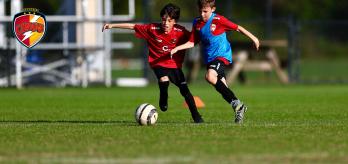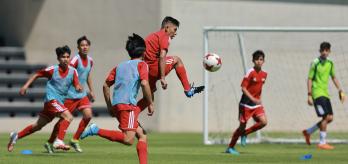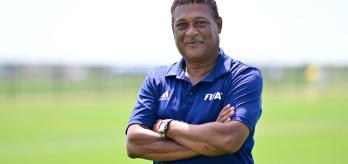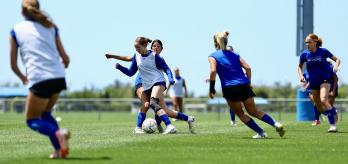Mike Keeney, the Executive Director of Chargers, oversees the club’s development structure, ensuring alignment between coaches across all campuses and age groups. “Each coach is working on the same things during the same weeks,” said Keeney. “For us, it’s more about teaching the skills and the objectives rather than trying to get a result at the weekend.”
DEVELOPMENT PRINCIPLES
Chargers achieve this through three core development principles: emphasising skill acquisition, making use of small-sided games, and implementing progressive training. In this article, Keeney explains why these principles are important to the overall methodology of Chargers, which is followed by a session led by U-12 head coach Adel Alchamat showcasing the club's fundamentals in action through three different exercises.
Principle 1: Emphasising skill acquisition
At Chargers, developing strong fundamentals with and without the ball from a young age is a top priority. The club focuses on helping players become confident and decisive with the ball, which lays the groundwork for introducing more complex tactical concepts later on.
“Our biggest focus is skill acquisition,” says Keeney. “Being comfortable with the ball and having a decision-making process in place that they can recognise and can implement right away.” To support this, Chargers SC use what Keeney describes as “technique on demand” – the ability to play the ball how and when a player chooses, under pressure or without it, and with either foot. “If we can do it with both feet, then we’re able to build the tactical traits after that,” he added.
Principle 2: Using small-sided games
Furthermore, rather than replicating full-sized matches too early, the club emphasises the continued use of small-sided games, even when the players compete in larger formats during competitive matches. “From ages 12 and younger, we tend to focus [on small-sided games] up to 5v5,” Keeney explains. “Even though they play bigger in the leagues and the competitions, we want the players to recognise these situations.”
The use of small-sided games, as discussed by Keeney, can be seen in the session videos in the second half of this article, including 1v1, 2v1 and 5v5 scenarios. The focus is primarily on skill development and ensuring that players have the correct technique while still practising their decision-making in congested areas.
Principle 3: Implementing progressive training
Chargers SC ensure that training is always progressive and that sessions are capped at no longer than 75 minutes to maintain the attention spans of players in this age group. “We lay the foundation and steadily build upon it,” Keeney noted. “We might start with individual ball work, then introduce an opponent, then add more pressure, and finish with a game scenario.”
“In addition, short, sharp actions keep their focus,” he said. “We don’t want players drifting off, so we prioritise small groups and lots of touches. The more we can do individually or in small groups, the more focused and engaged they stay. We try to keep it short and to the point while still building on the previous activity.”
U-12 Clearwater Chargers session
Keeney’s emphasis on technique, decision-making, and small-sided games shapes every layer of Chargers’ developmental framework. At the Florida-based club, coaches such as Alchamat bring this approach to life through dynamic and structured training.
The following session, led by Alchamat and filmed by the FIFA Training Centre, reflects the club’s commitment to combining foundational skill development with real-match application through small-sided games. In the session, Alchamat leads exercises on combination play, with an emphasis on the weight of pass and timed off-the-ball movement. It begins with a passing circuit, moves into a 3v1 rondo geared towards creating passing lanes, and finishes with a 5v5 game to reinforce the core ideas.
Part 1: Pass and finish
This warm-up passing drill focuses on the players’ development of passing and ball control skills. The aim is to time and weight the pass so that the ball can be progressed and create a shooting opportunity.
-
Using cones, mark out 3 stations in a line and place them 10 metres apart.
-
10 metres from the final station, position a mini-goal facing the cones.
-
Replicate the sequence parallel to this one.
-
Split the players into 2 groups of 6. 1 group per circuit.
-
Position a player on each of the final and second stations.
-
The player on the final cone is a number ‘9’, and the player on the second cone is a number ‘10’.
-
The remaining players are positioned at the starting station with a ball.
-
A player from the first station passes into the feet of the number 10.
-
The number 10 lays the ball off for the player who passed the ball.
-
The first player passes into the number 9, and at the same time, the number 10 moves toward the 9.
-
The number 9 lays the ball off for the number 10.
-
The number 10 then passes into the mini-goal.
-
Count the goals scored by each team.
-
The first player passes directly into the number 9.
-
The number 9 lays the ball off for the number 10 to finish into the mini-goal.
-
Passer and receiver must time their movements with verbal communication and gestures to show where they want the ball.
-
Adjust the weight of the pass to the situation. Forward passes must be played into feet and firm, whilst lay-offs must be lighter and into the teammate’s run.
-
The number 9 and number 10 must read the movement of one another. If the 9 moves to the left, the 10 must move in the opposite direction to create the passing angles.
-
The number 10 must focus on how the number 9 receives the ball and then get into the right position to support them and receive a lay-off.
Part 2: 3v1 Rondo
This second exercise focuses on the importance of creating passing lanes to facilitate the ball-carrier’s decision-making skills. This rondo provides players with the chance to hone their movement to create an angle for a pass.
-
Create two 10x10m areas.
-
Split the players into 2 groups of 4.
-
1 group per area.
-
1 player must be positioned inside the area and be the defender.
-
The other 3 players must position themselves around the edge of the area.
-
The 3 players around the edge of the area must keep the ball.
-
The 3 players can only pass to the left or to the right and not directly across the area.
-
The players try to make as many passes as possible in 90 seconds.
-
The defender must try to win the ball.
-
The winning team is the team with the most passes in 90 seconds.
-
Switch the defender in each group after each 90-second game
-
When the ball is travelling, the third player must make a movement to support the receiver.
-
By using the outside of the foot to pass to team-mates, players can confuse the defender.
-
Use feints and shimmies to distract the defender and open up passing opportunities.
Part 3: Small-sided game - 5v5
This final exercise presents the opportunity for players to use a numerical advantage and combination play to progress the ball in a 5v5 small-sided game.
-
Mark out a 50x30m pitch.
-
Position 2 mini-goals at either end of the pitch.
-
Split the group into 2 teams of 5 players.
-
Set each team up in a 3-2 formation.
-
The 3 defenders must stay in their half, and the 2 attacking players must remain in the opposite half.
-
The ball starts with the coach.
-
The coach passes the ball into the defence of the blue team.
-
The blue team must make 2 passes between them.
-
Once completed, they can progress the ball into the opposition’s half and try to score in the mini-goals.
-
Two players must join the attack to create a 4v3 overload.
-
Use the numerical advantage in the build-up to draw in defenders and break the press.
-
In the opposition’s half, use quick combinations and numerical advantages to create goalscoring opportunities.
-
Move into space and create passing angles as the ball is travelling.




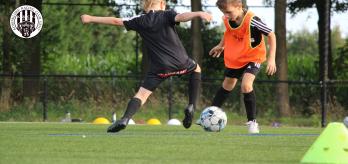
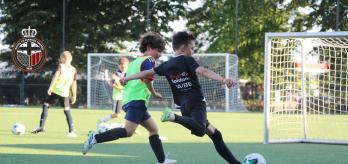
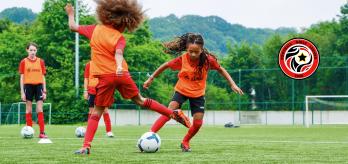
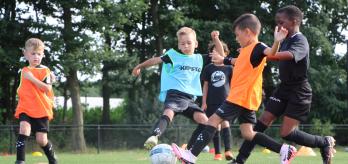

.variant64x64.jpg)

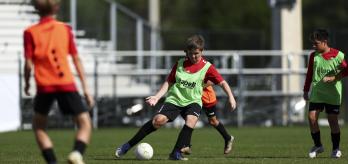
.variant348x164.jpg)
